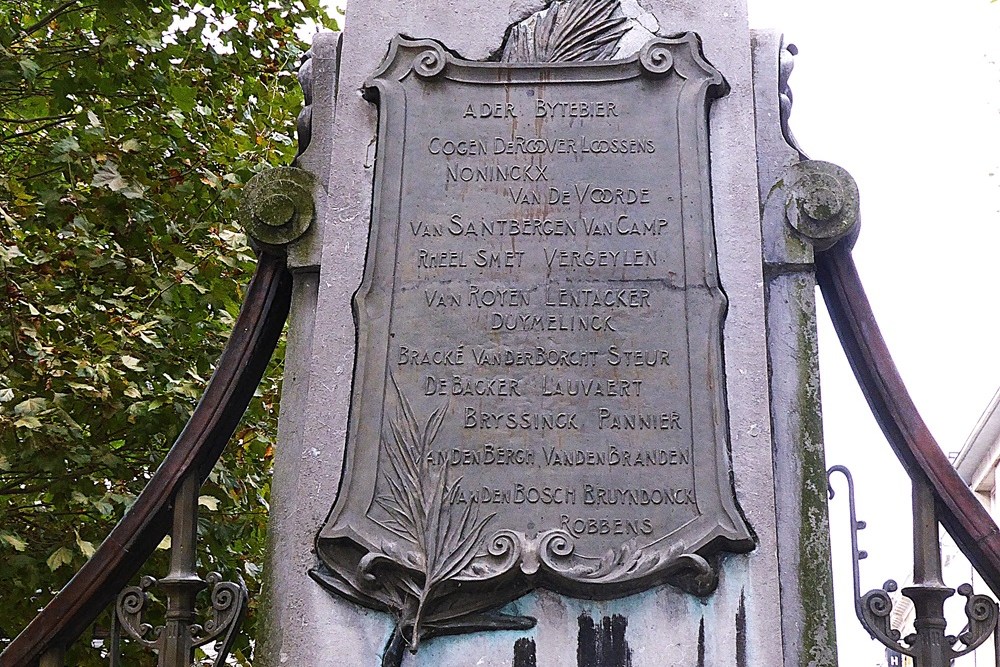Memorial Rolliers Sint-Niklaas
The monument on Regentieplein in Sint-Niklaas was inaugurated on June 241906 to mark the 75th anniversary of Belgium's independence. It was designed by Jozef Horenbant and August Waterschoot and executed by the Ghent sculptor Theo Soudeyns,
The pedestal of the monument is made of blue stone.
In front of the column is the bronze Belgian lion in half sitting, half lying position.
The actual monument is a triumphal column with a gilded bronze angel with spread wings at the top. The statue represents the allegory of peace, symbolized by the olive branch in the right hand and the laurel wreath for the honorably fallen in the left hand.
On the front of the column is a medallion in gilt bronze with the portrait of Benedikt Rolliers. Below the medallion is the inscription "BENEDIKT ROLLIERS, 1798-1877." Above the medallion the inscription "TO OUR STRIVERS OF 1830".
At the back of the column is a bronze plaque with the names of the 27 St. Nicholas volunteers of the 1830 independence struggle.
The monument has a dual purpose. On the one hand, it is in memory of the fighters of the revolution of 1830 and, on the other hand, a reference to the heroic act in 1831 of Saint-Nicolas Benedikt Rolliers.
On Feb. 2, 1831, the National Congress in Belgium would elect a new head of state but after the 1830 revolution, wealthy citizens, merchants and industrialists in particular saw their markets lost at Belgium's independence. Bruges and Ghent sought restoration of Dutch authority.
On the same day, a regiment led by Ernest Grégoire was on its way to Ghent to proclaim the Prince of Orange king. The regiment had set up at the governor's palace and detained the governor Werner de Lamberts-Cortenbach to force him to side with the Orangists.
Benedikt Rolliers, a sub-lieutenant in the Ghent fire department, went with a group of the Ghent fire department to the governor's palace and expelled Grégoire's regiment. In the process, there were several deaths. Ghent remained out of the hands of the Dutch and Brussels remained under Belgian control. The Provisional Government was able to continue and King Leopold I became the first king of independent Belgium.
Benedikt Rolliers received the rank of captain and several decorations for his deed.
Do you have more information about this location? Inform us!
Source
- Text: TracesOfWar
- Photos: Marie-Christine Vinck
Nearby
Point of interest
Monument
- War Memorial Sint-Niklaas - Sint-Niklaas
- Memorial Vercauteren Sint-Niklaas - Sint-Niklaas
- War Memorial Liberators Sint-Niklaas - Sint-Niklaas
Cemetery
- Belgian Graves Veterans Tereken-Sint-Niklaas - Sint-Niklaas
- Commonwealth War Graves Sint-Niklaas - Sint-Niklaas
- Belgian War Graves Tereken-Sint-Niklaas - Sint-Niklaas
Remembrance Stone
- Stumbling Stone Casinostraat 23 - Sint-Niklaas
- Stumbling Stones Veldstraat 89 - Sint-Niklaas
- Stumbling Stone Spoorweglaan 32 - Sint-Niklaas






